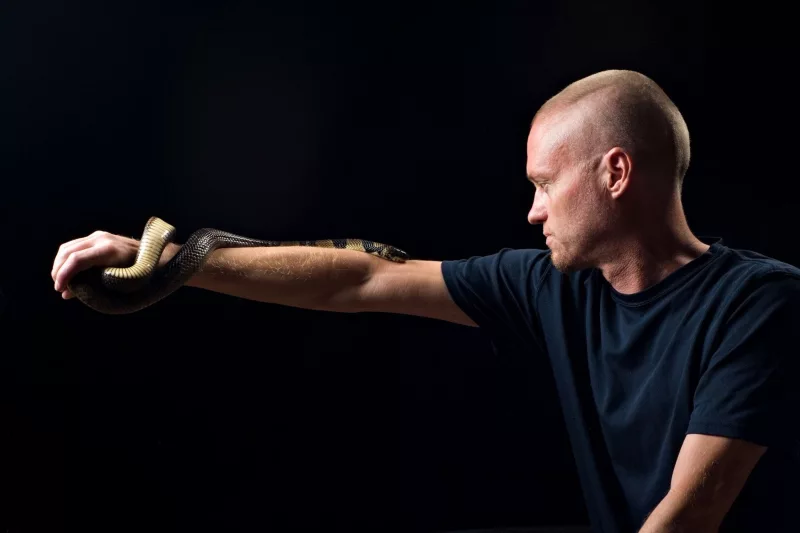He let snakes bite him 200 times to create a better antivenom

From NPR: "In 2001, after working up to it for years, Tim Friede finally allowed himself to be bitten by a snake. Friede has been fascinated with snakes for as long as he can remember. He used to hunt garter snakes growing up in Wisconsin. As an adult, his obsession turned to venomous snakes — and the harm they cause people globally. He felt the most dramatic way to raise awareness of the issue was to allow himself to be bit, repeatedly. Right out of the gate, he says, "I was put in ICU after two cobra bites and I dropped in a coma for four days." To date, he estimates he's willingly been bit some 200 times by all manner of venomous snakes — black mambas, taipans, cobras, kraits and many others. Friede's motivation evolved to see if he could develop immunity to this swirl of toxins — so that his body might provide a roadmap to making a broad kind of antivenom. Now, researchers say they've done just that, thanks in large part to the antibodies that Friede has developed over nearly a quarter century of self-envenomation."
Victorian ladies who wanted to lose weight infected themselves with tapeworms

From Atlas Obscura: "The Victorian era, roughly the 1830s to 1900, is notorious for its bizarre beauty standards, and the even more bizarre secrets to meeting them. The ideal of the time was modeled after those afflicted by consumption—that is, tuberculosis. Pale skin, dilated eyes, rosy cheeks, crimson lips, and a meagre and fragile figure. From swallowing ammonia to bathing in arsenic—which they knew to be poisonous— to using figure-molding corsets in a quest for the “perfect” 16-inch waist, there was no limit to what fashionable Victorians would do. Most of these practices have, thankfully, gone out of style. There is one gruesome dietary idea, however, that has managed to survive—the tapeworm diet. The idea is simple: you take a pill containing a tapeworm egg. Once hatched, the parasite grows, ingesting part of whatever the host eats. In theory, this enables the dieter to lose weight and eat without worrying about calorie intake."
A famous psychiatric study appears to have been fabricated

From Distillations: "In 1973 a bombshell study appeared in the scientific journal Science, called “On Being Sane in Insane Places.” Its author, a Stanford psychology professor named David Rosenhan, claimed that by faking their way into psychiatric hospitals, he and eight other pseudo-patients had proven that psychiatrists were unable to diagnose mental illness accurately. Psychiatrists panicked, and re-wrote what’s known as “psychiatry’s bible”—the Diagnostic and Statistical Manual of Mental Disorders, or DSM. The study and the subsequent overhaul of the DSM changed the field forever. So it was a surprise when, decades later, a journalist reopened Rosenhan’s files and discovered that the study was full of inconsistencies and even blatant fraud. So should we throw out everything it revealed? Or can something based on a lie contain any truths?"
Hi everyone! Mathew Ingram here. I am able to continue writing this newsletter in part because of your financial help and support, which you can do either through my Patreon or by upgrading your subscription to a monthly contribution. I enjoy gathering all of these links and sharing them with you, but it does take time, and your support makes it possible for me to do that. I also write a weekly newsletter of technology analysis called The Torment Nexus.
A secret room found in Peru shows that an ancient people used hallucinogens to govern

From La Brujula Verde: "Two thousand years before the Inca Empire extended its dominion over the Andes, a much less known yet culturally influential society—known as the Chavín Phenomenon—had already developed numerous artistic expressions, built monumental architectural structures, and created shared material practices throughout what is now Peruvian territory. This early civilization established a particular social order through agricultural innovations, specialized artisanal production, and exchange networks, laying the groundwork for what would later become a hierarchical society settled in the peaks of the Andes. But beyond agriculture or trade, the most powerful instrument of the Chavín leaders was not immediately visible. Their main weapon was controlled access to altered states of consciousness, a tool of power that, according to a recent study, played a central role in consolidating their authority."
This Japanese version of Joan of Arc fought off an army at the age of fifteen

From Wikipedia: "Ōhōri Tsuruhime was the third daughter of ther chief priest on the island of Ōmishima, southeast of Hiroshima. In 1534, a war broke out between the Ōuchi clan and the Kōno clan, and Tsuruhime's two elder brothers were killed. In 1541, when Tsuruhime was 15 years old, her father died of illness, and she inherited the position of chief priest. She had been trained since childhood in the martial arts, and when the Ōuchi made further attacks against Ōmishima, she led an armed resistance to defend the island. She led an army into battle and drove the Ōuchi samurai back into the sea. Four months later the invaders returned. Tsuruhime led troops in a surprise counterattack on the enemy ships. While an Ōuchi general was being entertained on his flagship, she successfully boarded general Takakoto's ship and summoned him to a duel."
She is a sniper with a slingshot
Being a sniper with a slingshot. pic.twitter.com/iLM7cUmSKm
— The Best (@Thebestfigen) May 2, 2025
Acknowledgements: I find a lot of these links myself, but I also get some from other newsletters that I rely on as "serendipity engines," such as The Morning News from Rosecrans Baldwin and Andrew Womack, Jodi Ettenberg's Curious About Everything, Dan Lewis's Now I Know, Robert Cottrell and Caroline Crampton's The Browser, Clive Thompson's Linkfest, Noah Brier and Colin Nagy's Why Is This Interesting, Maria Popova's The Marginalian, Sheehan Quirke AKA The Cultural Tutor, the Smithsonian magazine, and JSTOR Daily. If you come across something interesting that you think should be included here, please feel free to email me at mathew @ mathewingram dot com



